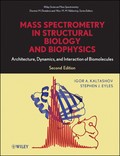Mass Spectrometry in Structural Biology and Biophysics
Architecture, Dynamics, and Interaction of Biomolecules
Wiley-Interscience Series on Mass Spectrometry

2. Edition April 2012
312 Pages, Hardcover
Wiley & Sons Ltd
Short Description
With its detailed and systematic coverage of the current state of biophysical mass spectrometry (MS), here is one of the first systematic presentations of the full experimental array of MS-based techniques used in biophysics, covering both fundamental and practical issues. The book presents a discussion of general biophysical concepts and a brief overview of traditional biophysical techniques before outlining the more advanced concepts of mass spectrometry. The new edition gives an up-to-date and expanded coverage of experimental methodologies and a clear look at MS-based methods for studying higher order structures and biopolymers. A must for researchers in the field of biophysics, structural biology, and protein chemistry.
With its detailed and systematic coverage of the current state of biophysical mass spectrometry (MS), here is one of the first systematic presentations of the full experimental array of MS-based techniques used in biophysics, covering both fundamental and practical issues. The book presents a discussion of general biophysical concepts and a brief overview of traditional biophysical techniques before outlining the more advanced concepts of mass spectrometry. The new edition gives an up-to-date and expanded coverage of experimental methodologies and a clear look at MS-based methods for studying higher order structures and biopolymers. A must for researchers in the field of biophysics, structural biology, and protein chemistry.
Preface to the First Edition xiii
1 General Overview of Basic Concepts in Molecular Biophysics 1
1.1 Covalent Structure of Biopolymers, 1
1.2 Noncovalent Interactions and Higher Order Structure, 3
1.3 The Protein Folding Problem, 9
1.4 Protein Energy Landscapes and the Folding Problem, 14
1.5 Protein Dynamics and Function, 17
1.6 Protein Higher Order Structure and Dynamics from A Biotechnology Perspective, 22
References, 22
2 Overview of Traditional Experimental Arsenal to Study Biomolecular Structure and Dynamics 26
2.1 X-Ray Crystallography, 26
2.2 Solution Scattering Techniques, 28
2.3 NMR Spectroscopy, 30
2.4 Other Spectroscopic Techniques, 34
2.5 Other Biophysical Methods to Study Macromolecular Interactions and Dynamics, 41
References, 48
3 Overview of Biological Mass Spectrometry 52
3.1 Basic Principles of Mass Spectrometry, 52
3.2 Methods of Producing Biomolecular Ions, 57
3.3 Mass Analysis, 63
3.4 Tandem Mass Spectrometry, 65
3.5 Brief Overview of Common Mass Analyzers, 72
References, 82
4 Mass Spectrometry Based Approaches to Study Biomolecular Higher Order Structure 89
4.1 Direct Methods of Structure Characterization: Native Electrospray Ionization Mass Spectrometry, 89
4.2 Chemical Cross-Linking for Characterization of Biomolecular Topography, 99
4.3 Mapping Solvent-Accessible Areas with Chemical Labeling and Footprinting Methods, 110
4.4 Hydrogen Exchange, 116
References, 119
5 Mass Spectrometry Based Approaches to Study Biomolecular Dynamics: Equilibrium Intermediates 127
5.1 Direct Methods of Monitoring Equilibrium Intermediates: Protein Ion Charge-State Distributions in ESI MS, 127
5.2 Chemical Labeling and Trapping Equilibrium States in Unfolding Experiments, 135
5.3 Structure and Dynamics of Intermediate Equilibrium States by Hydrogen Exchange, 137
5.4 Measurements of Local Patterns of Hydrogen Exchange in the Presence of Non-Native States, 146
References, 153
6 Kinetic Studies By Mass Spectrometry 160
6.1 Kinetics of Protein Folding, 160
6.2 Kinetics by Mass Spectrometry, 163
6.3 Kinetics of Protein Assembly, 174
6.4 Kinetics of Enzyme Catalysis, 178
References, 181
7 Protein Interactions: A Closer Look at the Structure--Dynamics--Function Triad 186
7.1 Direct Methods of Monitoring Protein Interactions with Their Physiological Partners in Solution by ESI MS: From Small Ligands to Other Biopolymers, 186
7.2 Assessment of Binding Affinity with Direct ESI MS Approaches, 189
7.3 Indirect Characterization of Non-covalent Interactions Under Physiological and Near-Physiological Conditions, 190
7.4 Indirect Characterization of Noncovalent Interactions Under Partially Denaturing Conditions, 194
7.5 Understanding Protein Action: Mechanistic Insights from the Analysis of Structure and Dynamics under Native Conditions, 198
7.6 Going Full Circle with MS: Native ESI MS Reveals Structural Changes Predicted by HDX MS Measurements, 201
7.7 Understanding Protein Action: Mechanistic Insights from the Analysis of Structure and Dynamics under Non-Native (Partially Denaturing) Conditions, 203
References, 206
8 Other Biopolymers and Synthetic Polymers of Biological Interest 212
8.1 Nucleic Acids, 212
8.2 Oligosaccharides, 223
8.3 Synthetic Polymers and their Conjugates with Biomolecules, 226
References, 233
9 Mass Spectrometry on the Frontiers of Molecular Biophysics and Structural Biology: Perspectives and Challenges 239
9.1 Mass Spectrometry and the Unique Challenges of Membrane Proteins, 239
9.2 The Protein Aggregation Problem, 249
9.3 The Many Faces of Complexity: Mass Spectrometry and the Problem of Structural Heterogeneity, 258
9.4 How Large Is "Too Large"? Mass Spectrometry in Characterization of Ordered Macromolecular Assemblies, 263
9.5 Complexity of Macromolecular Interactions In Vivo and Emerging Mass Spectrometry Based Methods to Probe Structure and Dynamics of Biomolecules in Their Native Environment, 269
References, 272
Appendix: Physics of Electrospray 279
Index 285
STEPHEN J. EYLES, PHD, is a Senior Lecturer in the Department of Biochemistry and Molecular Biology, and the Director of the Mass Spectrometry Center at the University of Massachusetts Amherst.


